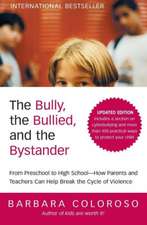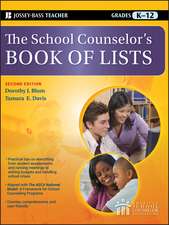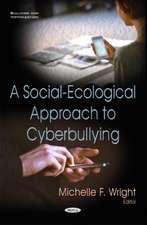School Climate 2.0: Preventing Cyberbullying and Sexting One Classroom at a Time
Autor Sameer K. Hinduja, Justin W. Patchinen Limba Engleză Paperback – 22 mai 2012
Peer mentoring
Social norming
Data-driven action plans
Youth grassroots campaigns
Multi-pronged policy and programming approaches by adults
Included are anecdotes, stories, and high-profile case examples that illustrate the research. The book's companion website features a Twitter feed and Facebook Fan Page with regular PreventionPoints you can put into action quickly, downloadable activities and worksheets, questions to facilitate staff and student discussions, and emerging best practices in school climate research and evaluation—powerful tools for bully-proofing your school.
Preț: 200.41 lei
Nou
Puncte Express: 301
Preț estimativ în valută:
38.35€ • 39.96$ • 31.75£
38.35€ • 39.96$ • 31.75£
Carte tipărită la comandă
Livrare economică 03-17 aprilie
Preluare comenzi: 021 569.72.76
Specificații
ISBN-13: 9781412997836
ISBN-10: 1412997836
Pagini: 216
Ilustrații: Illustrations
Dimensiuni: 178 x 254 x 13 mm
Greutate: 0.43 kg
Ediția:New.
Editura: SAGE Publications
Colecția Corwin
Locul publicării:Thousand Oaks, United States
ISBN-10: 1412997836
Pagini: 216
Ilustrații: Illustrations
Dimensiuni: 178 x 254 x 13 mm
Greutate: 0.43 kg
Ediția:New.
Editura: SAGE Publications
Colecția Corwin
Locul publicării:Thousand Oaks, United States
Recenzii
"Amidst
the
hysteria
surrounding
cyberbullying
and
sexting,
Hinduja
and
Patchin
represent
a
sane,
sensible
voice
that
helps
us
all
better
understand
these
phenomena
and
what
is
really
happening
here.
This
book
is
filled
with
useful
information
and
practical
tips
for
those
who
seek
to
create
positive
school
climates
where
bullying
of
all
kinds
is
minimized.
Every
educator
should
buy
it
and
read
it.”
“It is critical that educators, school administrators, parents, and technology companies work together to promote positive behavior – online and off. This practical guide provides important information, backed up by careful research, about the ways that adults can help build constructive dialogues and relationships with students.”
“Working with schools around the country, I know firsthand how much pressure there is to find an “answer” to bullying in schools, whether because of recent laws mandating programs and training or the community demanding answers. It’s hard to know what resource is best. It’s especially confusing because a bullying-prevention industry has bloomed to take advantage of this need but so many of these programs lack content based on a realistic analysis. I’m not at all surprised that Justin Patchin and Sameer Hinduja have created the resource all schools should use inSchool Climate 2.0, either to meet the new legal requirements or truly do the hard and comprehensive work of creating a culture of dignity in a school. From understanding the true dynamics of cyberbullying, to outlining a commonsense strategic plan for educators that will work with their individual community,School Climate 2.0to my mind is really the most important resource currently available. I will more than strongly advise every school I work with to use this book. Say it this way: if I could makeSchool Climate 2.0mandatory reading for every school administrator in the country, I would.”
"A rarely seen compendium of school strategies that have worked,School Climate 2.0moves past the headlines to offer a textured discussion of what we really need to strengthen school culture and improve teens’ and schools’ relationships to social media."
"Blaming technology is easy. Addressing the socio-cultural dynamics that shape young people’s lives is hard. Yet, to address hard problems like bullying and sexting, this is precisely what we need to do. InSchool Climate 2.0Sameer Hinduja and Justin W. Patchin flesh out the relationship between technologically mediated issues and school climate before offering valuable strategies for educators and community members to address problems in their schools. Both grounded and practical, this is a must-read for all who are scratching their heads about how to prevent bullying and sexting."
"Finally, a book that takes a holistic approach to the cyberbullying problem! There is no dividing line between school and home when it comes to the ways members of this generation relate to one another. A positive school climate can only help create a more positive home environment, and vice versa. This book gives readers specific guidance regarding how to prevent cyberbullying, sexting, and other problematic online behaviors."
"School Climate 2.0is a wise and practically helpful book. The authors are national leaders in cyberbullying. They present a helpful overview to the problem and most importantly a series of concrete suggestions about how we can make our schools safer, more supportive and engaging. In addition, the book is filled with “voices from the field”, prevention points, discussion questions at the end of the chapter which all serve to make this volume practically helpful to educators. I highly recommend it!"
"By cutting through all the media hype and speculation, Hinduja and Patchin present an accurate and helpful analysis of issues related to young people’s use of technology. By pointing out that the vast majority of youth are using technology safely and responsibly, they’re able to focus on the real issues, the real problems, and the kids who need our help. By basing their advice on rigorous research, they are able to come up with strategies that are effective and appropriate. I’m especially pleased that the authors focus on social norms and school climate by sharing insights into how the overall climate of a school affects the behavior of everyone in it."
"This is an immensely helpful and well-sourced book. It gives a thorough introduction to adolescents’ use of new technologies and sexting and cyberbullying. It makes a strong case that school climate is a vital factor in regulating these abuses. There are excellent chapters on how practical intervention strategies can be implemented in schools. It will be a great resource for teachers, educators, and parents."
"While Sameer Hinduja and Justin Patchin have a history of providing leadership in solid research and effective outreach on issues of youth risk in a digital age, in this book they have massively outdone their past excellence. Grounded in the understanding that the majority of young people make good choices online and effectively handle the negative situations that do occur, but that a minority of young people are at higher risk, Hinduja and Patchin craft recommendations for a positive school climate approach to help all young people learn to make good choices and assist their peers."
"Sameer Hinduja and Justin Patchin remind us early on that, contrary to most media hype, most young people use their ubiquitous technologies safety and responsibly the majority of the time. Then, they discuss how a positive school climate is fundamental for all of learning and teaching. They share innovative, pragmatic strategies to enhance climate and thereby foster a better social environment— which will reduce behavioral problems offline and online among youth. This very readable, very user-friendly book should be considered mandatory for all preservice teacher education programs and be used as a guide for planning ongoing inservice training as schools prepare to better meet the needs of their 21st century students."
"This book shared valuable information about social networks and texting that increased my awareness of their prevalence and potential legal consequences of student misuse."
"This book will help administrators lead their schools to form and keep policies that reduce or eliminate cyberbullying."
“It is critical that educators, school administrators, parents, and technology companies work together to promote positive behavior – online and off. This practical guide provides important information, backed up by careful research, about the ways that adults can help build constructive dialogues and relationships with students.”
“Working with schools around the country, I know firsthand how much pressure there is to find an “answer” to bullying in schools, whether because of recent laws mandating programs and training or the community demanding answers. It’s hard to know what resource is best. It’s especially confusing because a bullying-prevention industry has bloomed to take advantage of this need but so many of these programs lack content based on a realistic analysis. I’m not at all surprised that Justin Patchin and Sameer Hinduja have created the resource all schools should use inSchool Climate 2.0, either to meet the new legal requirements or truly do the hard and comprehensive work of creating a culture of dignity in a school. From understanding the true dynamics of cyberbullying, to outlining a commonsense strategic plan for educators that will work with their individual community,School Climate 2.0to my mind is really the most important resource currently available. I will more than strongly advise every school I work with to use this book. Say it this way: if I could makeSchool Climate 2.0mandatory reading for every school administrator in the country, I would.”
"A rarely seen compendium of school strategies that have worked,School Climate 2.0moves past the headlines to offer a textured discussion of what we really need to strengthen school culture and improve teens’ and schools’ relationships to social media."
"Blaming technology is easy. Addressing the socio-cultural dynamics that shape young people’s lives is hard. Yet, to address hard problems like bullying and sexting, this is precisely what we need to do. InSchool Climate 2.0Sameer Hinduja and Justin W. Patchin flesh out the relationship between technologically mediated issues and school climate before offering valuable strategies for educators and community members to address problems in their schools. Both grounded and practical, this is a must-read for all who are scratching their heads about how to prevent bullying and sexting."
"Finally, a book that takes a holistic approach to the cyberbullying problem! There is no dividing line between school and home when it comes to the ways members of this generation relate to one another. A positive school climate can only help create a more positive home environment, and vice versa. This book gives readers specific guidance regarding how to prevent cyberbullying, sexting, and other problematic online behaviors."
"School Climate 2.0is a wise and practically helpful book. The authors are national leaders in cyberbullying. They present a helpful overview to the problem and most importantly a series of concrete suggestions about how we can make our schools safer, more supportive and engaging. In addition, the book is filled with “voices from the field”, prevention points, discussion questions at the end of the chapter which all serve to make this volume practically helpful to educators. I highly recommend it!"
"By cutting through all the media hype and speculation, Hinduja and Patchin present an accurate and helpful analysis of issues related to young people’s use of technology. By pointing out that the vast majority of youth are using technology safely and responsibly, they’re able to focus on the real issues, the real problems, and the kids who need our help. By basing their advice on rigorous research, they are able to come up with strategies that are effective and appropriate. I’m especially pleased that the authors focus on social norms and school climate by sharing insights into how the overall climate of a school affects the behavior of everyone in it."
"This is an immensely helpful and well-sourced book. It gives a thorough introduction to adolescents’ use of new technologies and sexting and cyberbullying. It makes a strong case that school climate is a vital factor in regulating these abuses. There are excellent chapters on how practical intervention strategies can be implemented in schools. It will be a great resource for teachers, educators, and parents."
"While Sameer Hinduja and Justin Patchin have a history of providing leadership in solid research and effective outreach on issues of youth risk in a digital age, in this book they have massively outdone their past excellence. Grounded in the understanding that the majority of young people make good choices online and effectively handle the negative situations that do occur, but that a minority of young people are at higher risk, Hinduja and Patchin craft recommendations for a positive school climate approach to help all young people learn to make good choices and assist their peers."
"Sameer Hinduja and Justin Patchin remind us early on that, contrary to most media hype, most young people use their ubiquitous technologies safety and responsibly the majority of the time. Then, they discuss how a positive school climate is fundamental for all of learning and teaching. They share innovative, pragmatic strategies to enhance climate and thereby foster a better social environment— which will reduce behavioral problems offline and online among youth. This very readable, very user-friendly book should be considered mandatory for all preservice teacher education programs and be used as a guide for planning ongoing inservice training as schools prepare to better meet the needs of their 21st century students."
"This book shared valuable information about social networks and texting that increased my awareness of their prevalence and potential legal consequences of student misuse."
"This book will help administrators lead their schools to form and keep policies that reduce or eliminate cyberbullying."
Cuprins
Preface
Important Features of the Book
Breakdown of Chapters
Acknowledgments
About the Authors
1. Teens, Technology, and Trouble
The Story of Sam
What Would Happen to Sam Today?
Teens and Technology
Technology in Schools
Breakout Box: Delete Day
Why Schools Must Respond to Cyberbullying and Sexting
Technology Isn’t the Problem
The Power of a Positive School Climate
Summary
Discussion Questions
2. School Climate: Where It Begins and Ends
What Exactly Is School Climate?
Assessing Your School’s Climate
Breakout Box: A Positive School Climate Makes Everything Possible
Our School Climate Measure
School Climate and Behaviors at School
The Social Bond
Breakout Box: School Climate and Its Effect on School Social Issues
School Climate and Bullying
Breakout Bok: The Benefits of a Positive School Climate
Summary
Discussion Questions
3. Adolescent Mistreatment in the 21st Century: An Introduction to Cyberbullying
Bullying at School
Consequences of Bullying
What Is Cyberbullying?
Breakout Box: A Teenaged Target’s Cry for Help
The Cyberbullied
The Cyberbully
Where Does Cyberbullying Occur?
Correlates of Cyberbullying
Cyberbullying and Self-Esteem
Cyberbullying and Suicide
Cyberbullying and School-Related Delinquency and Violence
Unique Features of Cyberbullying
Breakout Box: Decoding your Digital Footprint
Breakout Box: Unique Characteristics of Cyberbullying
The Relationship Between Traditional Bullying and Cyberbullying
Summary
Discussion Questions
4. Adolescent Relationships in the 21st Century: An Introduction to Sexting
Sexting in the News
High Profile Incidents
Breakout Box: Adolescent Anger Lands Teen on the Sex Offender Registry
Why do Teens Engage in Sexting?
Sexting Images Go Viral
How Many Teens Really Participate in Sexting?
National Campaign to Prevent Teen and Unplanned Pregnancy
Cox Communications
MTV/AP
Pew Internet & American Life Project
Crimes Against Children Research Center
Our Own Survey
Sexting: A Continuum of Behaviors
Crimes Against Children Research Center Typology
Sexting and the Law
Breakout Box: Selected State Sexting Bills
Summary
Discussion Questions
5. School Climate and Online Misbehaviors
Breakout Box: School Climate and Cyberbullying
School Climate and Behaviors Online
Our Research
Educators' Efforts Matter
Whom Do Targets Tell About Their Experiences With Cyberbullying?
Expectation of Discipline
Summary
Discussion Questions
6. Strategies for Improving Your School Climate
Top-Down Approach
Know Their Names
Community Building
Small Teacher-Student Ratios
Stay in the Loop
Clearly Define What Is “Not Cool”
Breakout Box: Staying in the Loop: What I’ve Learned by Listening and Understanding
Monitor Behaviors and Respond Fairly and Consistently to Problems
Encourage Active Student Participation in Decision Making
Student-Teacher Evaluations
Encourage Reporting of Any Inappropriate Behavior
Cultivate Hope
The Important Role of School Counselors
Breakout Box: School Counselors Can Help
Inform and Involve the Community
Continue to Lay the Groundwork
Use Resources Available to You
Breakout Box: What YOU Can Do to Spark Climate Change in Your School
Summary
Discussion Questions
7. It Takes a Village: Social Norms, Bystanders, and Peer Mentoring
Social Norming
An Overview of Social Norms Theory
Social Norms Theory and Traditional Bullying
Using Social Norming to Prevent Cyberbullying and Sexting
Coordinate a Student Play
Breakout Box: Using Stage Productions to Enhance School Climate
Role-Playing
Solidarity Walk or March
Four Corners
Breakout Box: Canadian Initiatives: Students Making a Difference Against Bullying
Pledges
Stop Standing By and Start Standing Up!
Breakout Box: Minnesota Twins
Peer Mentoring
Summary
Discussion Questions
8. Prevention Through Assessment: Taking the Pulse of Your School and Students
Survey Your Students
Breakout Box: Talking Points: How to Conduct Research Among Your Students
Sampling
Breakout Box: Use Data to Guide Your Climate Improvement Efforts
Survey Development
Survey Administration
Breakout Box: Assessment Leads to Better Understanding
Don’t Forget About the Adults!
Focus Groups
Breakout Box: Sample Focus Group Questions
Confidentiality, Consent, and Ethical Issues
Summary
Discussion Questions
Appendix A: Our Survey Questions
Appendix B: Psychometric Properties for Cyberbullying Scale
9. Effective Prevention Requires Effective Response
Can Schools Respond to Behaviors That Occur Away From Campus?
Just Say No to “Zero Tolerance”: Utilize Informal Responses When Appropriate
Natural and Logical Consequences
Breakout Box: What Schools Should Do When Made Aware of a Cyberbullying Incident
When Can Educators Search the Contents of Student Cell Phones?
Special Considerations When Responding to Sexting Incidents
Breakout Box: What Schools Should Do When Made Aware of a Sexting Incident
Policy Issues
Cyberbullying
Breakout Box: Elements of a Cyberbullying Policy
Sexting
Breakout Box: Elements of a School Sexting Policy
When to Get Law Enforcement Involved
Educate Students About the Consequences Before the Behavior
Breakout Box: One School’s Response to Social Networking Drama
A Call for Education and Outreach
Summary
Discussion Questions
Index
Important Features of the Book
Breakdown of Chapters
Acknowledgments
About the Authors
1. Teens, Technology, and Trouble
The Story of Sam
What Would Happen to Sam Today?
Teens and Technology
Technology in Schools
Breakout Box: Delete Day
Why Schools Must Respond to Cyberbullying and Sexting
Technology Isn’t the Problem
The Power of a Positive School Climate
Summary
Discussion Questions
2. School Climate: Where It Begins and Ends
What Exactly Is School Climate?
Assessing Your School’s Climate
Breakout Box: A Positive School Climate Makes Everything Possible
Our School Climate Measure
School Climate and Behaviors at School
The Social Bond
Breakout Box: School Climate and Its Effect on School Social Issues
School Climate and Bullying
Breakout Bok: The Benefits of a Positive School Climate
Summary
Discussion Questions
3. Adolescent Mistreatment in the 21st Century: An Introduction to Cyberbullying
Bullying at School
Consequences of Bullying
What Is Cyberbullying?
Breakout Box: A Teenaged Target’s Cry for Help
The Cyberbullied
The Cyberbully
Where Does Cyberbullying Occur?
Correlates of Cyberbullying
Cyberbullying and Self-Esteem
Cyberbullying and Suicide
Cyberbullying and School-Related Delinquency and Violence
Unique Features of Cyberbullying
Breakout Box: Decoding your Digital Footprint
Breakout Box: Unique Characteristics of Cyberbullying
The Relationship Between Traditional Bullying and Cyberbullying
Summary
Discussion Questions
4. Adolescent Relationships in the 21st Century: An Introduction to Sexting
Sexting in the News
High Profile Incidents
Breakout Box: Adolescent Anger Lands Teen on the Sex Offender Registry
Why do Teens Engage in Sexting?
Sexting Images Go Viral
How Many Teens Really Participate in Sexting?
National Campaign to Prevent Teen and Unplanned Pregnancy
Cox Communications
MTV/AP
Pew Internet & American Life Project
Crimes Against Children Research Center
Our Own Survey
Sexting: A Continuum of Behaviors
Crimes Against Children Research Center Typology
Sexting and the Law
Breakout Box: Selected State Sexting Bills
Summary
Discussion Questions
5. School Climate and Online Misbehaviors
Breakout Box: School Climate and Cyberbullying
School Climate and Behaviors Online
Our Research
Educators' Efforts Matter
Whom Do Targets Tell About Their Experiences With Cyberbullying?
Expectation of Discipline
Summary
Discussion Questions
6. Strategies for Improving Your School Climate
Top-Down Approach
Know Their Names
Community Building
Small Teacher-Student Ratios
Stay in the Loop
Clearly Define What Is “Not Cool”
Breakout Box: Staying in the Loop: What I’ve Learned by Listening and Understanding
Monitor Behaviors and Respond Fairly and Consistently to Problems
Encourage Active Student Participation in Decision Making
Student-Teacher Evaluations
Encourage Reporting of Any Inappropriate Behavior
Cultivate Hope
The Important Role of School Counselors
Breakout Box: School Counselors Can Help
Inform and Involve the Community
Continue to Lay the Groundwork
Use Resources Available to You
Breakout Box: What YOU Can Do to Spark Climate Change in Your School
Summary
Discussion Questions
7. It Takes a Village: Social Norms, Bystanders, and Peer Mentoring
Social Norming
An Overview of Social Norms Theory
Social Norms Theory and Traditional Bullying
Using Social Norming to Prevent Cyberbullying and Sexting
Coordinate a Student Play
Breakout Box: Using Stage Productions to Enhance School Climate
Role-Playing
Solidarity Walk or March
Four Corners
Breakout Box: Canadian Initiatives: Students Making a Difference Against Bullying
Pledges
Stop Standing By and Start Standing Up!
Breakout Box: Minnesota Twins
Peer Mentoring
Summary
Discussion Questions
8. Prevention Through Assessment: Taking the Pulse of Your School and Students
Survey Your Students
Breakout Box: Talking Points: How to Conduct Research Among Your Students
Sampling
Breakout Box: Use Data to Guide Your Climate Improvement Efforts
Survey Development
Survey Administration
Breakout Box: Assessment Leads to Better Understanding
Don’t Forget About the Adults!
Focus Groups
Breakout Box: Sample Focus Group Questions
Confidentiality, Consent, and Ethical Issues
Summary
Discussion Questions
Appendix A: Our Survey Questions
Appendix B: Psychometric Properties for Cyberbullying Scale
9. Effective Prevention Requires Effective Response
Can Schools Respond to Behaviors That Occur Away From Campus?
Just Say No to “Zero Tolerance”: Utilize Informal Responses When Appropriate
Natural and Logical Consequences
Breakout Box: What Schools Should Do When Made Aware of a Cyberbullying Incident
When Can Educators Search the Contents of Student Cell Phones?
Special Considerations When Responding to Sexting Incidents
Breakout Box: What Schools Should Do When Made Aware of a Sexting Incident
Policy Issues
Cyberbullying
Breakout Box: Elements of a Cyberbullying Policy
Sexting
Breakout Box: Elements of a School Sexting Policy
When to Get Law Enforcement Involved
Educate Students About the Consequences Before the Behavior
Breakout Box: One School’s Response to Social Networking Drama
A Call for Education and Outreach
Summary
Discussion Questions
Index
Notă biografică
Descriere
This
book
discusses
the
full
extent
and
nature
of
teen
technology
use.
It
breaks
down
what
cyberbullying
is
and
how
it
is
different
from
traditional
bullying,
including
the
relatively
new
phenomenon
of
sexting.
There
are
strategies
to
empower
students
and
staff
to
prevent
cyberbullying
and
sexting.











